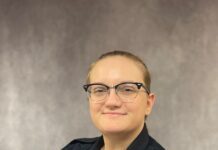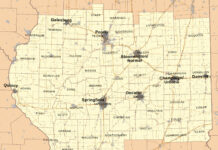Peoria Public Schools District 150 (PPS) will be adding new surveillance tools to its schools. The district already has over 800 cameras on its campuses. The school board approved a $48,000 contract with IntelliSee, a company that provides risk-mitigation surveillance software, at its July 25th, 2022 board meeting.
The software uses artificial intelligence to identify potential risks that range from weapons to fall hazards to unauthorized access in certain areas. Once identified, it will notify the appropriate person about the risk. If there’s a spill somewhere, a janitor will be notified; if a potential weapon is detected, school resource officers (SRO) and Peoria police would be notified.
Currently, the contract with IntelliSee only covers 64 cameras (approximately 8% of the districts total arsenal), and the software will be used on both internal & external cameras. Demario Boone, director of school safety for PPS, advocated for the new software saying the district is being proactive, preventative, and progressive.

Boone mentioned the Uvalde massacre as an impetus for acquiring the new technology. “The incident that happened in Uvalde, Texas, where the young man wrecked a vehicle outside of the building.” Boone said at the school board. “Walked into the building, with the long-rifle, and made his way to a class room. With IntelliSee, we’ll get that information right when he walks out of that vehicle. So, the officers would be able to neutralize the threat outside of the building. Instead of letting someone come inside.”
Yet, it’s not clear how this software would have prevented the Uvalde shooting. Contrary to Boone’s narrative, it was known the shooter had a weapon as soon as he exited his crashed vehicle because he immediately began shooting at people. The shooter gained access to the building not because no one knew he had a gun, but because the locking mechanism on the door failed, something IntelliSee software could not prevent. One school employee saw the shooter walking towards the door with a rifle and closed the door. The Uvalde police tried to frame this staff member by saying the staff member never closed the door.1
The Uvalde massacre, which is now turning into a state-wide cover-up, occurred because of the incompetence & cowardice of the officers present. Why Boone is spreading the false narratives of the Uvalde police department is unknown; the Uvalde police have been caught in so many lies about the incident that it is hard to keep track of. But, these narratives are part of trend that has increased police in schools, militarized the police, and created the school-to-prison pipeline where disciplinary infractions are criminalized.
In an interview with me, Boone also mentioned several local shootings as reason for the new technology. “This isn’t marketed for just students,” Boone told me. “We had multiple shootings outside of schools that I had to burn footage of and solved 3 cases.”
He mentioned several shootings on Frye Street, one of which occurred on Frye & Atlantic street, several blocks away from any school and out-of-range of any District cameras. Another shooting occurred on Republic & Delaware, right next to Glen Oak school, but it’s not clear how accurate the software is at a distance. Boone did not provide an answer to the software’s efficacy at a distance saying, “It’s for safety reasons; deterrent for anyone thinking of bringing a firearm in or near ANY building.” Boone says as long as people don’t know the software’s efficacy at a distance “they will think it’s super far. I just don’t want guns near any school.”
Boone refused to identify which cameras would be utilizing the new technology citing safety reasons.
IntelliSee’s Chief Commercial Officer, Maureen Pajerski, told the school board preventing accidental falls could save the district on average $50,000 per fall. Pajerski admitted to the school board the most frequent false positives involved suspected firearms.

When asked about the risks of a false positive for firearms, Boone told the Peoria Journal Star, “The computer learns as it evolves,” he said. “If somebody is holding a phone and it flags it as a firearm, we’re able to see, ‘OK, that’s not a firearm, it’s a phone,’ and the computer, the AI, learns from that.”
Boone told me that there were other options for risk-mitigation surveillance software that he reviewed. Another company, ZeroEyes, with similar software was rejected because it automatically notified the local police of a suspected gun. Boone chose IntelliSee over ZeroEyes because firearm notifications would be sent to school resource officers first. This would allow someone already on the scene and with more information to respond first.
But, what if an officer looking through a security camera at a person one hundred meters away, can’t tell it’s a phone, or a flute case, or any number of objects that from a distance could be mistaken as a firearm? Will such a false positive result in someone (probably a student) being swarmed by police officers with guns blazing?
Some might say they’d rather have false positives & be wrong, than not detect them in the first place. But again, does everyone just walking down the street going passed a school have to worry they’ll be stopped (or even potentially killed) by police because of a false positive?
This new software follows a trend in Peoria of increased surveillance, policing, and criminalization. Back in 2019, the City of Peoria directly purchased Ring doorbells for citizens in order to connect these surveillance devices to the local police. Recently, Peoria approved the purchase of automatic license plate readers for the Peoria Police Department.
From the Peoria Journal Star, “Last year, the district added more metal detectors at some schools to help screen people when they enter the schools. This year the district will employ 29 officers. While that’s not enough to keep an officer in each of the district’s 27 schools full-time, officers have the ability to monitor security cameras remotely.”
It’s not clear why it would be most beneficial to have every school staffed with SROs full-time. All PPS schools are already constantly on a soft lockdown, with all doors locked, according to Boone.
The shootings near Glen Oak and at Uvalde, Texas were at elementary schools. Boone says SROs are rarely stationed at elementary schools. Despite the massive increase in school police nationally over the last twenty years (ostensibly in reaction to school shootings), most SROs will go their entire careers without ever having a school shooting incident. So, what do SROs actually do with 99% of their time? They police & criminalize student behavior, which contributes to the school-to-prison pipeline. SROs aren’t typically at elementary schools because 1) school shootings make up a tiny fraction of all gun violence nationally; and 2) the behavior of elementary school students is not nearly as policed compared to middle & high school students.
The $48,000 contract with IntelliSee for 64 cameras means each camera costs $750 to run the software. While this contract is only for one year and only to test it out, if the software were eventually applied to all 800 of PPS surveillance cameras, it could cost upwards of $600,000 a year (assuming the $750 per camera price tag). The trend tends to be once this technology is purchased & implemented, it never goes away and is often expanded.


























